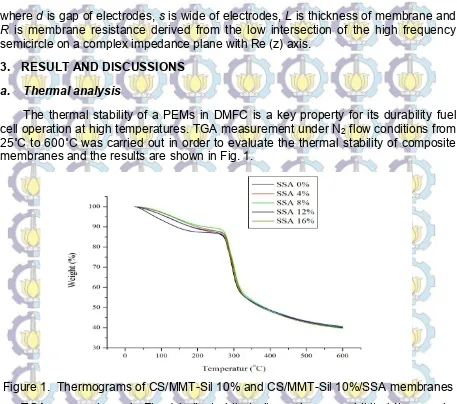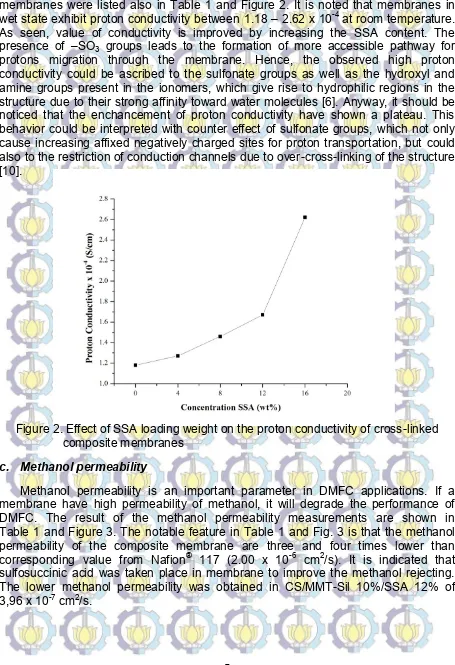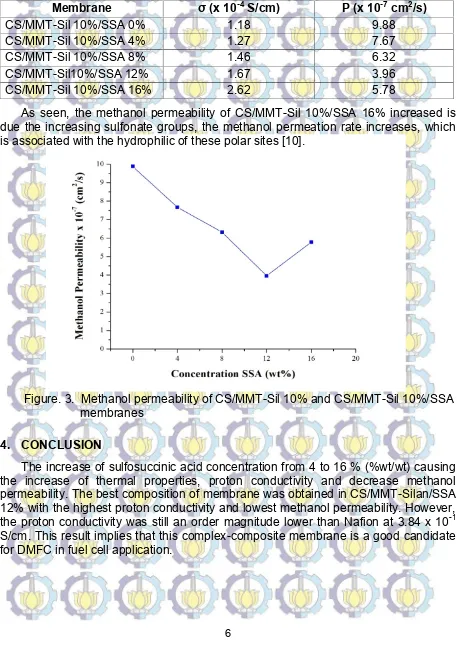EFFECTS OF SULFOSUCCINIC ACID TO THE
PERFORMANCE OF COMPOSITE MEMBRANE FOR
DMFC APPLICATION
Matius Stefanus Batu
Departemen of Chemistry, Institut Teknologi Sepuluh Nopember, Surabaya, Indonesia email :[email protected]
Lukman Atmaja
Departemen of Chemistry, Institut Teknologi Sepuluh Nopember, Surabaya, Indonesia email :[email protected]
Dian Permana
Departemen of Chemistry, Institut Teknologi Sepuluh Nopember, Surabaya, Indonesia email :[email protected]
Abstract – Membrane is the main component of a fuel cell that serves as a separator between the cathode and anode as well as a proton conductor medium. In this research, chitosan (CS) had been used as matrix and montmorillonite (MMT) as filler. Prior to be used, the filler was modified by silane 10%, and sulfosuccinic acid (SSA) was used as cross linking agent. The aim of this research is to explore the effect of the addition of sulfosuccinic acid to the special properties of composite membrane. The optimum composition obtained was CS/MMT-Sil 10%/SSA 12%, which shows the highest proton conductivity and the lowest methanol permeability. The usage of combined CS, MMT and SSA could be considered as a promising polyelectrolyte membrane for DMFC applications.
Keywords : Sulfosuccinic Acid, DMFC, Proton Conductivity, Methanol Permeability.
1. INTRODUCTION
The development about new sustainable and economical energy source with low emission have been attracting much attention recently to overcome environmental pollution and global warming. In this regard, fuel cell technology as a promosing candidate has attracted considerable interest during the past year. The fuel cell is an electrochemical device, which converts the chemical energy of its reactant directly into the electricity and heat without combustion [1]. Several favorable advantages such as savings in fossil fuels, high efficiency of energy conversion, low pollution level, low noise and low maintanance cost render the fuel cells preferable over the other energy conversion devices [2].
High methanol permeability not only reduces fuel efficiency and performance, but also reduces the performance of cathode [4-5].
Therefore, the development of new alternative hybrid membranes that will provided improved character, environmental benign, and low production cost for fuel cell application is highly required. The new DMFCs membranes require several important properties, including good film formation, high methanol rejection, good mechanical stability and hydrophilic character to allow sufficient ionic conductivity [6-7].
Chitosan is a natural biopolymer with a unique character as a biocompatible, biodegradable, non toxic, environmental benign, good chemical and thermal stability, and low methanol permeability. Chitosan can be obtained from chitin, a polysaccharide that contains N-acetyl-D-glucosamine that is easily prepared from shells of crabs, shrimp and prawns [8]. Although it has low ionic conductivity compared to Nafion, but it has low methanol permeability. Therefore, it makes chitosan membrane is an excellent to be futher developed [9].
In this study, DMFCs membranes were prepared from mixture of chitosan (CS) as matrix and montmorillonite (MMT) modified by silane 10% as filler. Meanwhile, sulfosuccinic acid (SSA) with various concentration as cross linking agent has been chosen for enhance proton conductivity of hybrid membrane. Hopefully, the formation of polyelectrolyte hybrid composite membranes from both CS/MMT-Sil 10% and CS/MMT-Sil 10%/SSA are expected to improve their conductivity, rejecting methanol and thermal stability. the aim of this research is to explore the effect of the addition of sulfosuccinic acid to the special properties of composite membrane for DMFC by analysis the thermal stability, proton conductivity and methanol permeability.
2. EXPERIMENTAL
2.1 Materials
Chitosan was synthesized from isolated chitin from Black Tiger shrimp shell (Penaeus monodon), Montmorillonite Na-MMT K-10 (surface area : 220-270 m2/g), (3-glycidyloxypropyl)trimethoxy silane and Sulfosuccinic acid (SSA, 70% solution in water) were purchased from Sigma Aldrich. Sodium hydroxide, Acetic acid, Methanol and Hydrocloride acid were purchased from Merck. De-ionized water was used in all experiments.
2.2 Membrane Preparation
L
NaOH solution, washed by demineralized water to remove the excess and unbound ions. Finally, the membranes were dried at room temperature. The membranes were donated as CS/MMT-Sil 10%/SSA 0%, CS/MMT-Sil 10%/SSA 4%, CS/MMT-Sil 10%/SSA 8%, CS/MMT-Sil 10%/SSA 12%, CS/MMT-Sil 10%/SSA 16%.
2.3 Characterization
a. Thermal analysis
The degradation and thermal stability of the composite membranes was studied using a TGA 50 shimadzu themogravimetric analyzer at heating rate of 10˚C/min from 25 to 600˚C. The nitrogen flow was maintained at 40 mL/min. Before the analysis, the samples were dried under vacuum until constant weight.
b. Methanol permeability
Methanol permeability was measured by means of a two compartement glass diffusion cell. The first cell contained pure methanol (cell A), and the second one contained deionizated water (cell B), a mixer stirred both solution continuously to make them homogeneous. The concentration of methanol diffused from cell A to B across the membranes were examined with time using density meter. The amount of 10 mL was sampled from the cell B every 20 min. before the permeation experiment, the calibration curve of the density vs the methanol concentration was prepared. The calibration curve was used to calculate the methanol concentration in the permeation experiment. The methanol permeability was calculated from slope of the straight-line plot of methanol concentration vs the permeation time. The methanol concentration in the cell B as a function of time is given in Eq. 1 [11] :
where C is the methanol concentration, A and L are the composite membrane area and thinkness, D and K are the methanol diffusivity and partion coefficient between the membrane and the solution. The product DK is the membrane permeability (P), t0also termed time lag, which is related to the diffusivity : t0– L2/6D.
c. Proton conductivity
Proton conductivity of fully hydrate membranes were measured as a function of temperature. Measurements were carried out two point-probe conductivity cells using two platinum wire electrodes as working electrode. The electric resistance data were obtained using impedance analyzer (AglientTM E4980A) and were recorded between 20 Hz – 2 MHz at working voltage amplitude of 1 V. The impedance spectra were fitted on ZView 2 software by Scribner Associates Inc. for curve fitting procedure. The proton conductivity values were obtained according to Eq 2 :
wheredis gap of electrodes, sis wide of electrodes,L is thickness of membrane and
R is membrane resistance derived from the low intersection of the high frequency semicircle on a complex impedance plane with Re (z) axis.
3. RESULT AND DISCUSSIONS
a. Thermal analysis
The thermal stability of a PEMs in DMFC is a key property for its durability fuel cell operation at high temperatures. TGA measurement under N2flow conditions from
25˚C to 600˚C was carried out in order to evaluate the thermal stability of composite membranes and the results are shown in Fig. 1.
Figure 1. Thermograms of CS/MMT-Sil 10% and CS/MMT-Sil 10%/SSA membranes
TGA curves shown in Fig. 1 indicated that all membranes exhibited three major weight loss stages. The first weight loss region (50-100˚C) was attributed to the loss of adsorbed water molecules in the membranes. The second weight loss (210-300˚C) was corresponded to the degradation of the bond between chitosan-silane and chitosan-SSA in the membranes. The third weight loss (310-450˚C) was attributed to the decomposition of chitosan chains [12]. Through the comparison of the modified and pure composite membranes thermogram, it is understood that thanks to the formation of covalent and ionic interactions, the thermal stability of cross-linked chitosan network of composite membrane has been improved. The cross-linked membranes were stable at the desired operating temperature range of DMFC applications [10].
b. Proton Conductivity
membranes were listed also in Table 1 and Figure 2. It is noted that membranes in wet state exhibit proton conductivity between 1.18 – 2.62 x 10-4at room temperature. As seen, value of conductivity is improved by increasing the SSA content. The presence of –SO3 groups leads to the formation of more accessible pathway for
protons migration through the membrane. Hence, the observed high proton conductivity could be ascribed to the sulfonate groups as well as the hydroxyl and amine groups present in the ionomers, which give rise to hydrophilic regions in the structure due to their strong affinity toward water molecules [6]. Anyway, it should be noticed that the enchancement of proton conductivity have shown a plateau. This behavior could be interpreted with counter effect of sulfonate groups, which not only cause increasing affixed negatively charged sites for proton transportation, but could also to the restriction of conduction channels due to over-cross-linking of the structure [10].
Figure 2. Effect of SSA loading weight on the proton conductivity of cross-linked composite membranes
c. Methanol permeability
Table 1. Proton Conductivity and Methanol Permeability of CS/MMT-Sil 10% and CS/MMT-Sil 10%/SSA
Membrane σ (x 10-4S/cm) P (x 10-7cm2/s)
CS/MMT-Sil 10%/SSA 0% 1.18 9.88
CS/MMT-Sil 10%/SSA 4% 1.27 7.67
CS/MMT-Sil 10%/SSA 8% 1.46 6.32
CS/MMT-Sil10%/SSA 12% 1.67 3.96
CS/MMT-Sil 10%/SSA 16% 2.62 5.78
As seen, the methanol permeability of CS/MMT-Sil 10%/SSA 16% increased is due the increasing sulfonate groups, the methanol permeation rate increases, which is associated with the hydrophilic of these polar sites [10].
Figure. 3. Methanol permeability of CS/MMT-Sil 10% and CS/MMT-Sil 10%/SSA membranes
4. CONCLUSION
5. ACKNOWLEDGMENTS
The first author is thankful to Direktorat Jenderal Pendidikan Tinggi (DIKTI) for their post-graduate scholarship. We thank Dr. Bambang Prijamboedi and Dr. Veinardi Suendo for their help in the proton conductivity measurements.
6. REFERENCES
[1] W. Vielstich, A. Lamm, H. A. Gasteiger, Handbook of fuel cells, Fundamental, Technology and Applications,2003, 1, p. 79-85.
[2] B. Smitha, S. Sridhar, A. A. Khan,J. Memb.Sci.2005,259, p. 10-26. [3] K. D. Kreuer,J. Memb.Sci.2001, 185,p. 29-39
[4] M. Rikukawa, K. Sanui,Prog. Polymer Science,2000, 25,p.1463-1502. [5] M. I. Ahmad, S.M.J. Zaidi, S. U. Rahman, Desalination,2005, 93, p. 387-397. [6] B. Smitha, S. Sridhar, A. A. Khan,Macromolecules.2004, 37, p. 2233-2239. [7] H. Wu, B. Zheng, X. Zheng, J. Wang, W. Yuan, Z. Jiang, J.Power Sources.
2007, 173, p. 842-852.
[8] H. S. Tsai, Y. Z. Wang,Polymer Bulletin,2008, 60, p. 103-113.
[9] Y. Wan, B. Peppley, K. A. M. Creber, V. Tam Bui, J. Power Sources,2010, 195, p. 3785-3793.
[10] E. Dastimoghadam, M. M. Hasani-Sadrabadi, H. Moaddel,Polymers Advanced Technoogies,2010, 21, p. 726-734.
[11] C. C. Yang, Y. J. Lee, J. N. Yang,J. Power Sources,2009,188, p. 30-37.
[12] J. Wang, X. Zheng, H. Wu, B. Zheng, Z. Jiang, X. Hao, B. Wang, J. Power Sources,2008, 178, p. 9-19.


